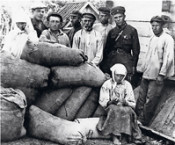
State grain monopoly introduced in Russia
March 25 (April 7), 1917 the Act of the Provisional Government “On transfer of grain in the custody of the State" introduced in Russia the state grain monopoly.
The state declared the grain monopoly due to a deep food crisis generated by war. Already in August 1915, in order to ensure the military needs, in Russia were introduced fixed prices for grain for government procurement, and in December 1916, authorities were forced to launch a surplus-appropriation system - a multilevel distribution of commitments for the supply of grain between the provinces, counties, villages and individual farms.
These measures had not saved the situation and the Provisional Government, which came to power after the February Revolution, introduced the grain monopoly March 25 (7 April), 1917. The law "On the transfer of grain in the custody of the State” consisted of twenty-two articles and a number of applications for the ninth article on setting fixed prices for grain. The entire amount of "grain, bread and fodder, harvest of previous years, of the year 1916 and the future harvest of 1917”, was to be transferred to the state. Producer could only afford to keep the legally established minimum for seeding the fields, life-support of his family and employed persons, as well as for economic necessity (feed the animals).
Each owner of grain was obliged to report to local food committees information about the available quantity of bread. All the grain was subject to delivery in a timely manner at a fixed price. The hidden stocks of grain, found at the inspection, were alienated in favor of the state for half the price. The grain, kept by individuals refusing to deliver it voluntary, was requisitioned.
The grain, obtained by the state, was subject to distribution to consumers at fixed prices established in places of purchase, with the addition of the necessary overhead. Pledge of grain and other similar operations of "free trade" were forbidden.
The Act and the subsequent additional measures had not given the expected results. The peasants were unwilling to donate their products at a low price, without appropriate compensation with industrial products. The most serious resistance was offered by landlords and rich peasants.
Alternative to the grain monopoly in the situation of revolution and civil war had not been found, so the Soviet government also resorted to it. In May 1918, were issued the decrees: "On granting to the People's Commissariat for Food emergency powers to combat rural bourgeoisie, concealing grain stocks and speculating them" and "On reorganization of the People's Commissariat for Food and local food authorities”, and January 1, 1919 under decree of the Council of People's Commissars throughout Soviet Russia was introduced the surplus-appropriation system.
Lit.: Белозерцев А. Г. Земля и хлеб России (1900—2005 гг.). М., 2005; Волобуев П. В. Экономическая политика Временного правительства. М., 1962; Данилов В. П. Крестьянская революция в России, 1902-1922 гг. // Крестьяне и власть. М.; Тамбов, 1996. С. 4-23; Деникин А. И. Очерки русской смуты. Т. 1. Париж, 1921. Гл. 14: Деятельность Временного правительства: продовольствие, промышленность, транспорт и финансы; То же [Электронный ресурс]. URL: http://militera.lib.ru/h/denikin_ai2/1_14.html; Китанина Т. М. Война, хлеб и революция: Продовольственный вопрос в России. 1914 — октябрь 1917 г. Л., 1985; Рябова Т. Ф., Куделя А. Д. Развитие рынка зерна в России, 1896—1996. М., 1997; Собрание узаконений и распоряжений правительства. Пг., 1917. № 85, ст. 487; Сидоров А. Л. Экономическое положение России в годы Первой мировой войны. М., 1973.
Based on the Presidential Library’s materials:

